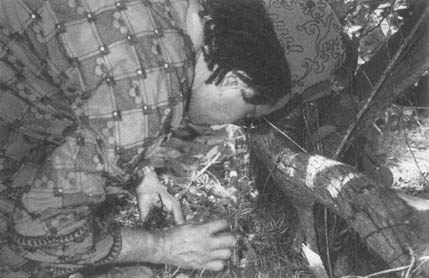whatever map was in his head. As we wound into one neighborhood-I'd lost my bearings by this pointof fifties-era ranch style houses fallen into disrepair, with blocked-up cars cluttering the driveways, I had the distinct feeling of being lost. It looked creepy, filled with cul-de-sacs and maze-like streets flanked by moss-covered trees. The residents, hard-looking Anglos, were what some Southerners call white trash. The vibes seemed about as unvoudou as I could imagine.
|
But Ajamu said to keep going, he knew there was this place ... and then he saw it. I stopped next to a half-filled drainage ditch leading toward a dense clump of cane and brush twice a grown man's height. Ajamu got out, jumped the ditch, then disappeared for a moment in the underbrush. "Ashé," I heard him call out over the sounds of a machete's chop. He came out with the leaves of a small vine he didn't identify, and put them on the pile atop the towel. He was sweating but. smiling, not so much because of getting the plant, but from remembering where it was.
|
He went back into the grove, and I could hear an exclamation of delight. He had spotted an avocado tree, from which he took the leaves, not the fruit, and near that picked the plant called elephant ear. Locked and loaded, we drove on to other neighborhoodsblack, white, Cuban, middle-class, poorstopping for "Wandering Jew," for the jaguey, for castor bean, and, across the alley from a convenience store in a starkly poor Hispanic neighborhood, for cuttings of the needle-like peregun, a favorite of Ogun.
|
Then we were at the western edge of Little Haiti. Before we reached the main strip of brightly decorated businesses, restaurants, clubs, churches and botanicas along Second Avenue, we pulled into a street of hard-luck houses near a crosstown overpass. Ajamu directed me to a driveway just past a two-room shotgun shack where four or five men in T-shirts, sunglasses and pork pie hats sat on a sagging porch. I wasn't sure if Ajamu
|
|


